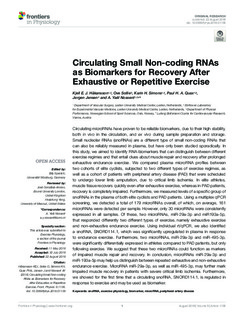| dc.description.abstract | Circulating microRNAs have proven to be reliable biomarkers, due to their high stability, both in vivo in the circulation, and ex vivo during sample preparation and storage. Small nucleolar RNAs (snoRNAs) are a different type of small non-coding RNAs that can also be reliably measured in plasma, but have only been studied sporadically. In this study, we aimed to identify RNA-biomarkers that can distinguish between different exercise regimes and that entail clues about muscle repair and recovery after prolonged exhaustive endurance exercise. We compared plasma microRNA profiles between two cohorts of elite cyclists, subjected to two different types of exercise regimes, as well as a cohort of patients with peripheral artery disease (PAD) that were scheduled to undergo lower limb amputation, due to critical limb ischemia. In elite athletes, muscle tissue recovers quickly even after exhaustive exercise, whereas in PAD patients, recovery is completely impaired. Furthermore, we measured levels of a specific group of snoRNAs in the plasma of both elite cyclists and PAD patients. Using a multiplex qPCR screening, we detected a total of 179 microRNAs overall, of which, on average, 161 microRNAs were detected per sample. However, only 30 microRNAs were consistently expressed in all samples. Of these, two microRNAs, miR-29a-3p and miR193a-5p, that responded differently two different types of exercise, namely exhaustive exercise and non-exhaustive endurance exercise. Using individual rt/qPCR, we also identified a snoRNA, SNORD114.1, which was significantly upregulated in plasma in response to endurance exercise. Furthermore, two microRNAs, miR-29a-3p and miR-495-3p, were significantly differentially expressed in athletes compared to PAD patients, but only following exercise. We suggest that these two microRNAs could function as markers of impaired muscle repair and recovery. In conclusion, microRNAs miR-29a-3p and miR-193a-5p may help us distinguish between repeated exhaustive and non-exhaustive endurance exercise. MicroRNA miR-29a-3p, as well as miR-495-3p, may further mark impaired muscle recovery in patients with severe critical limb ischemia. Furthermore, we showed for the first time that a circulating snoRNA, SNORD114.1, is regulated in response to exercise and may be used as biomarker. | nb_NO |
